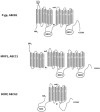Recent advances in the search of BCRP- and dual P-gp/BCRP-based multidrug resistance modulators
- PMID: 35582565
- PMCID: PMC8992508
- DOI: 10.20517/cdr.2019.31
Recent advances in the search of BCRP- and dual P-gp/BCRP-based multidrug resistance modulators
Abstract
The development of multidrug resistance (MDR) is one of the major challenges to the success of chemotherapy treatment of cancer. This phenomenon is often associated with the overexpression of the ATP-binding cassette (ABC) transporters P-gp (P-glycoprotein, ABCB1), multidrug resistance-associated protein 1, ABCC1 and breast cancer resistance protein, ABCG2 (BCRP). These transporters are constitutively expressed in many tissues playing relevant protective roles by the regulation of the permeability of biological membranes, but they are also overexpressed in malignant tissues. P-gp is the first efflux transporter discovered to be involved in cancer drug resistance, and over the years, inhibitors of this pump have been disclosed to administer them in combination with chemotherapeutic agents. Three generations of inhibitors of P-gp have been examined in preclinical and clinical studies; however, these trials have largely failed to demonstrate that coadministration of pump inhibitors elicits an improvement in therapeutic efficacy of antitumor agents, although some of the latest compounds show better results. Therefore, new and innovative strategies, such as the fallback to natural products and the discover of dual activity ligands emerged as new perspectives. BCRP is the most recently ABC protein identified to be involved in multidrug resistance. It is overexpressed in several haematological and solid tumours together with P-gp, threatening the therapeutic effectiveness of different chemotherapeutic drugs. The chemistry of recently described BCRP inhibitors and dual P-gp/BCRP inhibitors, as well as their preliminary pharmacological evaluation are discussed, and the most recent advances concerning these kinds of MDR modulators are reviewed.
Keywords: ATP-binding cassette transporter inhibitors; Cancer; P-glycoprotein; breast cancer resistance protein; multidrug resistance; multidrug resistance modulators; multidrug resistance-associated proteins.
© The Author(s) 2019.
Conflict of interest statement
All authors declared that there are no conflicts of interest.
Figures
























Similar articles
-
Dacomitinib antagonizes multidrug resistance (MDR) in cancer cells by inhibiting the efflux activity of ABCB1 and ABCG2 transporters.Cancer Lett. 2018 May 1;421:186-198. doi: 10.1016/j.canlet.2018.01.021. Epub 2018 Jan 11. Cancer Lett. 2018. PMID: 29331420
-
5-Oxo-hexahydroquinoline derivatives as modulators of P-gp, MRP1 and BCRP transporters to overcome multidrug resistance in cancer cells.Toxicol Appl Pharmacol. 2019 Jan 1;362:136-149. doi: 10.1016/j.taap.2018.10.025. Epub 2018 Nov 2. Toxicol Appl Pharmacol. 2019. PMID: 30391378
-
β-carotene reverses multidrug resistant cancer cells by selectively modulating human P-glycoprotein function.Phytomedicine. 2016 Mar 15;23(3):316-23. doi: 10.1016/j.phymed.2016.01.008. Epub 2016 Feb 6. Phytomedicine. 2016. PMID: 26969385
-
Mammalian drug efflux transporters of the ATP binding cassette (ABC) family in multidrug resistance: A review of the past decade.Cancer Lett. 2016 Jan 1;370(1):153-64. doi: 10.1016/j.canlet.2015.10.010. Epub 2015 Oct 20. Cancer Lett. 2016. PMID: 26499806 Review.
-
ABC Transporter-Mediated Multidrug-Resistant Cancer.Adv Exp Med Biol. 2019;1141:549-580. doi: 10.1007/978-981-13-7647-4_12. Adv Exp Med Biol. 2019. PMID: 31571174 Review.
Cited by
-
Intricate relationship between cancer stemness, metastasis, and drug resistance.MedComm (2020). 2024 Sep 21;5(10):e710. doi: 10.1002/mco2.710. eCollection 2024 Oct. MedComm (2020). 2024. PMID: 39309691 Free PMC article. Review.
-
Dual Inhibition of P-gp and BCRP Improves Oral Topotecan Bioavailability in Rodents.Pharmaceutics. 2021 Apr 15;13(4):559. doi: 10.3390/pharmaceutics13040559. Pharmaceutics. 2021. PMID: 33921129 Free PMC article.
-
Exploring the next generation of antibody-drug conjugates.Nat Rev Clin Oncol. 2024 Mar;21(3):203-223. doi: 10.1038/s41571-023-00850-2. Epub 2024 Jan 8. Nat Rev Clin Oncol. 2024. PMID: 38191923 Review.
-
Ellagic Acid and Schisandrins: Natural Biaryl Polyphenols with Therapeutic Potential to Overcome Multidrug Resistance in Cancer.Cells. 2021 Feb 21;10(2):458. doi: 10.3390/cells10020458. Cells. 2021. PMID: 33669953 Free PMC article. Review.
-
Analysis of P-Glycoprotein Transport Cycle Reveals a New Way to Identify Efflux Inhibitors.ACS Omega. 2022 Nov 16;7(47):42835-42844. doi: 10.1021/acsomega.2c04768. eCollection 2022 Nov 29. ACS Omega. 2022. PMID: 36467933 Free PMC article.
References
-
- Chien AJ, Moasser MM. Cellular mechanisms of resistance to anthracyclines and taxanes in cancer: intrinsic and acquired. Semin Oncol. 2008;35:S1–S14. Quiz S39. - PubMed
-
- Kane SE. Multidrug resistance of cancer cells. In: Testa B, Meyer U, editors. Advances in Drug Research vol.28. New York: Academic Press; 1996. pp. 181–252.
-
- Mitscher LA, Pillai SP, Gentry EJ, Shankel DM. Multiple drug resistance. Med Res Rev. 1999;19:477–96. - PubMed
Publication types
LinkOut - more resources
Full Text Sources
Research Materials
Miscellaneous
